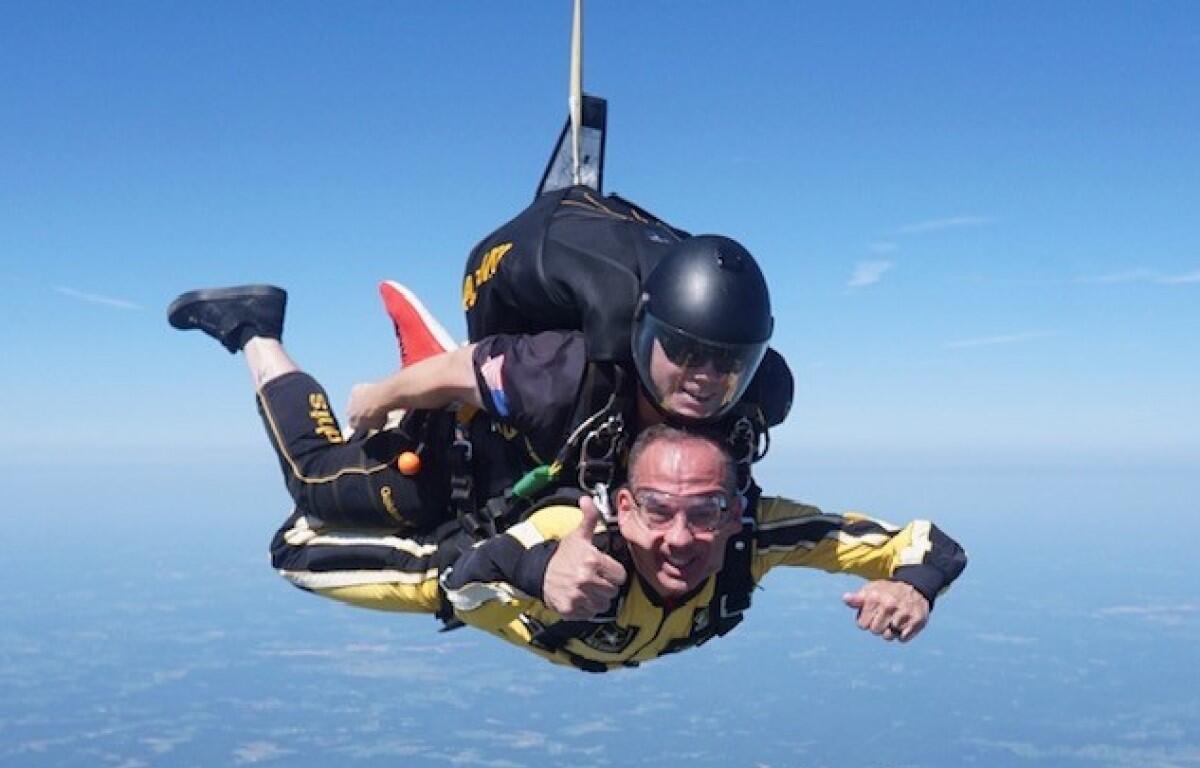CLARKSVILLE, TN – As he soared thousands of feet in the air over central Kentucky at speeds approaching 120 mph, it was hard to imagine that Kris Phillips, Austin Peay State University’s vice president for alumni, engagement and philanthropy, had just celebrated his grandson’s birth a week ago.
A longstanding fear of heights made Phillips’s leap from a military aircraft even more daunting. Still, he was in good company: the United States Army Parachute Team, also known as the Golden Knights, supervised the experience and paired him with a seasoned tandem jumper.
Phillips and Dr. Chad Brooks, dean of APSU’s College of Graduate Studies, were among several higher education and community leaders who jumped with the Golden Knights on July 12 at Addington Field, just outside Fort Knox, Kentucky. The United States Army Cadet Command (USACC), which supervises ROTC programs at 274 schools, is headquartered at Fort Knox and coordinated the event.
“We’re trying to educate professionals around campus about the opportunities available for students through ROTC,” said Lt. Col. Mark Barton, a professor of military science who oversees Austin Peay’s ROTC program. “Every summer, USACC brings the Golden Knights to Fort Knox and asks schools around the country if they have any [faculty or staff] who support the ROTC program and would benefit from learning more about the Golden Knights and what ROTC does.”
Phillips and Brooks were chosen to participate because of their support for Austin Peay’s military population and their families – from Phillips’ work raising money to fund the ROTC program to Brooks’ history of acquiring military-focused grants and training opportunities for active-duty and retired soldiers and their families. After a thorough safety briefing, they suited up and prepared to jump from approximately 13,000 feet.
“Before we took off, the soldier asked me what my limits were, and I told him that my limits are whatever his limits are plus two levels,” Brooks said. “From there, he basically said ‘game on.’”
Phillips said a photographer leaped out of the plane before each jumper to capture their experience, which involved freefalling and parachuting.
“It seemed like a long time, but you’re really in the air for just a couple of minutes,” he said. “Once you got in the air, it was quiet and serene … I didn’t hear anything. It was a spiritual thing for me, looking around as I was freefalling through the air.”
After adjusting to the environment, Brooks decided to make the most of his time in freefall.
“When you’re first jumping out of the plane, the initial sensation is just figuring out which way is up and which way is down because your inner ear doesn’t tell you,”he said. “After that, I just played like a fish, using my arms to move in the air, do spins and just have fun. That lasts about a minute before the parachute deploys, and you realize how fast you’re going because you slow down pretty quickly.”
From there, Brooks’ tandem jumper allowed him to guide the parachute through a series of barrel rolls and serpentine motions before taking back over for landing. Meanwhile, Phillips’ partner shared the history behind the Army’s parachuting operations.
“He would talk about the different theatres of war as we descended various altitudes,” Phillips said. “He would point out, ‘This is where we jumped in World War II, this is where we jumped during this conflict,’ and so on. It was humbling to gain the historical perspective of what I experienced in the air.”
For more information on Austin Peay’s Governors Guard Battalion, visit https://www.apsu.edu/rotc/. To learn more about the Golden Knights, visit https://www.goarmy.com/golden-knights.html.


